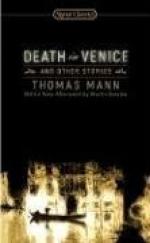|
This section contains 4,945 words (approx. 17 pages at 300 words per page) |

|
SOURCE: Robertson, Ritchie. “Classicism and Its Pitfalls: Death in Venice.” In The Cambridge Companion to Thomas Mann, edited by Ritchie Robertson, pp. 95-106. Cambridge: Cambridge University Press, 2002.
In the following essay, Robertson argues that in Death in Venice Mann “dramatizes the strengths, the weaknesses and the pitfalls of classicism, in its different versions, through the career of a writer dedicated to a classical ideal.”
While staying in Venice with his wife and brother between 26 May and 2 June 1911, Thomas Mann, like his fictional Aschenbach, was fascinated by a handsome Polish boy whom he watched playing on the beach. This ‘personal and lyrical experience’, as Mann later described it in a much-quoted confessional letter, prompted the story Death in Venice.1 And just as Mann's protagonist Aschenbach is inspired by the sight of Tadzio to write ‘a page and a half of exquisite prose’ on an unspecified problem of taste and...
|
This section contains 4,945 words (approx. 17 pages at 300 words per page) |

|


